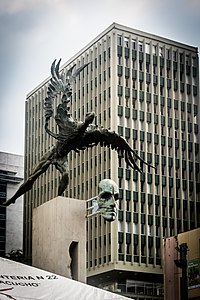Draft:«Bolívar Cóndor»
 | Draft article not currently submitted for review.
This is a draft Articles for creation (AfC) submission. It is not currently pending review. While there are no deadlines, abandoned drafts may be deleted after six months. To edit the draft click on the "Edit" tab at the top of the window. To be accepted, a draft should:
It is strongly discouraged to write about yourself, your business or employer. If you do so, you must declare it. Where to get help
How to improve a draft
You can also browse Wikipedia:Featured articles and Wikipedia:Good articles to find examples of Wikipedia's best writing on topics similar to your proposed article. Improving your odds of a speedy review To improve your odds of a faster review, tag your draft with relevant WikiProject tags using the button below. This will let reviewers know a new draft has been submitted in their area of interest. For instance, if you wrote about a female astronomer, you would want to add the Biography, Astronomy, and Women scientists tags. Editor resources
Last edited by Bsoyka (talk | contribs) 36 days ago. (Update) |
| Bolívar Cóndor | |
|---|---|
 | |
| Artist | |
| Year | 12 October 1991 |
| Type | Bronze |
| Dimensions | 13.5 cm (5.3 in) |
| Location | Manizales, |
Bolívar Cóndor is a bronze sculpture created by Colombian artist Rodrigo Arenas Betancourt and installed since 1991 in the Plaza de Bolívar in Manizales, Colombia. The sculpture depicts Simón Bolívar.
History
[edit]The idea of giving Manizales another monument to the liberator Simón Bolívar originated around 1986, during the administration of engineer Hernando Arango Monedero, when a new Plaza de Bolívar was built in a European style with steps, similar to a half-circle. The old, classic, and centuries-old sculpture by Pietro Tenerani, on a tall pedestal, appeared lost and out of place with the surroundings. Thus, the idea emerged to create a monument that would harmonize with the urban appearance of the plaza, the cathedral, and the government building.
The project was supported by the Sociedad de Mejoras Públicas de Manizales, the Ministry of Public Works, the Governorship of Caldas, and the municipality of Manizales. They contracted the artist Rodrigo Arenas Betancourt to sculpt a new monument for the city, with a budget of 73 million pesos.
At its unveiling, the sculpture sparked controversy due to its boldness and imposing presence. This work deviates from the historical tradition or the static coldness of conventional monuments typically used to represent Simón Bolívar.
The Sculpture
[edit]


Meaning
[edit]Instead of eyes, the condor has holes, symbolizing the blindness of life and existence. It features two negative masks of Bolívar embedded in the pedestal, representing Bolívar in the shadows. These masks are illuminated day and night to contrast with the volumes that project into the space. Hanging from the pedestal near the base is a bronze mask of Bolívar, with one eye missing and the other damaged, symbolizing peace and freedom in suspense.
The man-condor figure has broken areas in the chest and wings, representing expressions of violence. It is difficult to determine whether the man-condor is perched on the mountain or preparing to take flight. The piece associates the Andes with the image of a submerged Bolívar.
Characteristics
[edit]The sculpture stands 13.5 meters tall and weighs 25 tons, resting on its left foot, which is attached to a metal base on a 12.54-meter pedestal. It is located on the southwestern side of the Plaza de Bolívar.
See Also
[edit]References
[edit]- ^ El Tiempo (26 August 1991). "EL BOLÍVAR-CÓNDOR VUELA" (in Spanish). Retrieved 10 July 2016.
